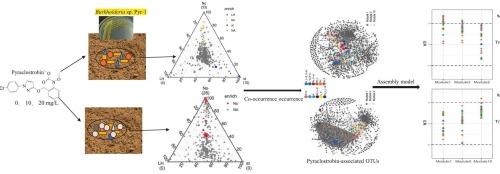揭示Burkholderia sp. Pyr-1驱动土壤微生物群落功能和组装去除pyraclostrobin污染的机制
IF 5
2区 农林科学
Q1 SOIL SCIENCE
引用次数: 0
摘要
吡咯菌酯是一种常用的污染环境的杀菌剂,其残留的去除引起了人们的广泛关注。然而,吡咯菌酯对土壤细菌群落的影响尚不清楚。本研究采用高通量测序技术,研究了高、低剂量吡唑菌酯及其降解菌Burkholderia sp. Pyr-1对土壤微生物群落的影响。结果表明,当细菌浓度大于108 CFU/g时,土壤在14 d内的降解率大于96%。菌株Pyr-1显著改变了土壤微生物群落结构。具体来说,高浓度pyraclostrobin降低了系统发育多样性,而菌株Pyr-1的引入缓解了这种影响。随着时间的推移,Pyr-1驱动pyraclostrobin相关菌株在土壤微生物网络的特定模块内的组装。关键类群的成员使嘧菌酯在土壤中的降解和微生物群落在富集模块中的聚集主要受随机过程驱动。本研究为pyraclostrobin及其降解菌株Pyr-1对土壤微生物群落的功能和组装效应提供了新的见解。本文章由计算机程序翻译,如有差异,请以英文原文为准。

Revealing the mechanism of Burkholderia sp. Pyr-1 driven removal of pyraclostrobin-contamination through soil microbial community function and assembly
Pyraclostrobin is a commonly used fungicide that pollutes the environment, and removing its residue has attracted widespread interest. However, the effect of pyraclostrobin on soil bacterial communities remain unknown. This study employed high-throughput sequencing to investigate the effects of high and low doses of pyraclostrobin, as well as its degrading strain Burkholderia sp. Pyr-1, on soil microbial communities. The results revealed that soil with bacterial concentrations exceeding 108 CFU/g achieved a degradation percentage greater than 96 % within 14 days. Notably, strain Pyr-1 significantly altered the structure of soil microbial communities. Specifically, high concentrations of pyraclostrobin reduced phylogenetic diversity, whereas the introduction of strain Pyr-1 alleviated this effect. Over time, Pyr-1 drove the assembly of pyraclostrobin-associated strains within specific modules of the soil microbial network. Members of keystone taxa enabled the pyraclostrobin degradation in soil, and microbial community assembly in enriched modules predominantly driven by stochastic processes. This study provides novel insights into the functional and assembly effects of pyraclostrobin and its degrading strain Pyr-1 on soil microbial communities.
求助全文
通过发布文献求助,成功后即可免费获取论文全文。
去求助
来源期刊

Applied Soil Ecology
农林科学-土壤科学
CiteScore
9.70
自引率
4.20%
发文量
363
审稿时长
5.3 months
期刊介绍:
Applied Soil Ecology addresses the role of soil organisms and their interactions in relation to: sustainability and productivity, nutrient cycling and other soil processes, the maintenance of soil functions, the impact of human activities on soil ecosystems and bio(techno)logical control of soil-inhabiting pests, diseases and weeds.
 求助内容:
求助内容: 应助结果提醒方式:
应助结果提醒方式:


